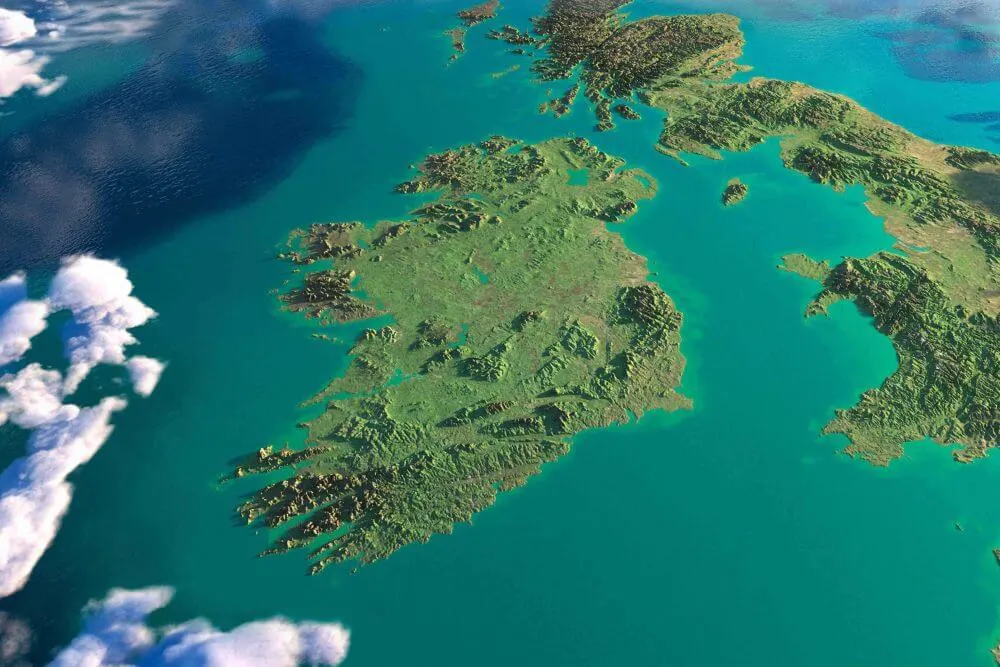
Table of Contents
- 1 What is Ireland known for Guide
- 2 What is Ireland?
- 3 What is Ireland famous for?
- 4 Ireland is famous for what products?
- 5 What things are associated with Ireland?
- 6 Things Ireland is Known For
- 7 St. Patrick’s Day
- 8 Guinness
- 9 Irish Whiskey
- 10 Irish Food
- 11 Irish Pubs
- 12 Irish Castles
- 13 Irish Blessings
- 14 Irish Literature
- 15 Irish Sports
- 16 Irish Music
- 17 Ireland Filming Locations
- 18 Famous Irish People
- 19 Ireland Famous Landmarks
- 20 Irish Symbols
What is Ireland known for Guide
If you have ever wondered what is Ireland known for, then here you will find the ultimate list of things associated with Ireland and what Irish people are famous for all over the world.
This guide will provide you with:
- interesting facts about Ireland
- details covering famous things in Ireland
- an overview of famous people from Ireland
- things that originated in Ireland
- best places to visit in Ireland and what to do in Ireland
So why don’t you just take this list of famous Ireland facts and weird Irish trivia as a travel inspiration to plan a trip to Ireland soon? The Emerald Isle is waiting for you!
What is Ireland?
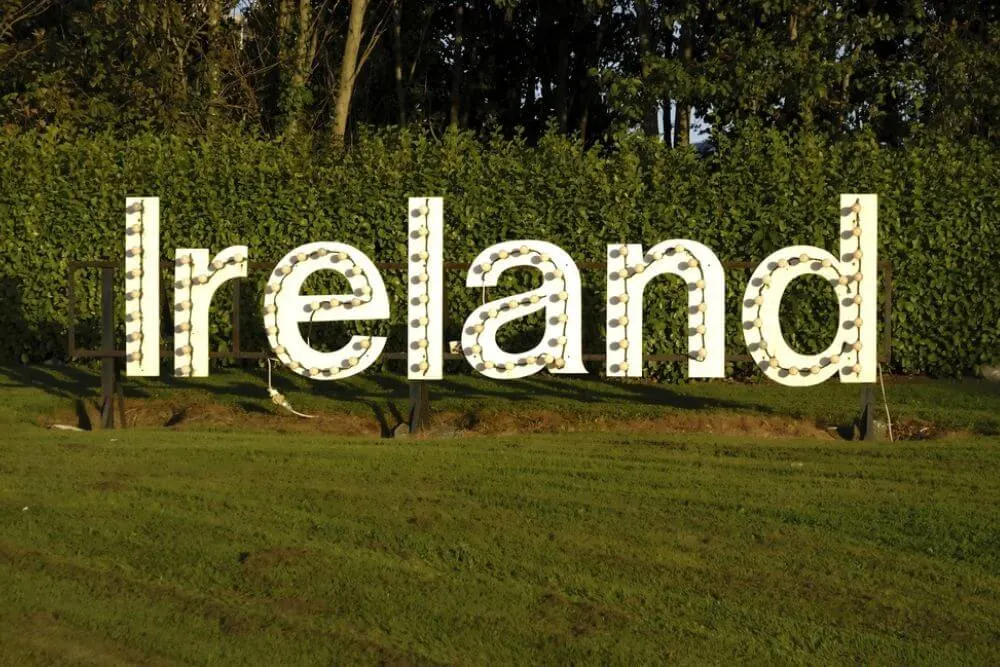
First things first, the island of Ireland is situated on the western edge of Europe.
It consists of the Republic of Ireland (also known as Ireland), which has been an independent country since the early 20th century, and Northern Ireland. Northern Irelandis part of the United Kingdom.
Ireland’s many green pastures have helped it attain its nickname as the Emerald Isle. However, due to the country’s long history of Christianity, Ireland is known as the Land of Saints and Scholars to many as well.
Ireland has a population of about 5 million people and is roughly 85,000 km2 (ca, 33,000 sq miles, which approximately equates to the size of South Carolina).
The Irish Republic is divided into 26 counties. Dublin is the capital city and seat of the government.(To find out what is Dublin famous for, check out the must-see attractions)
Both the English language and the Irish language are officially recognised as state languages. Since 1973 Ireland has been a member of the European Union and the national currency is the Euro.
The national flag is a tricolor of green, white and orange vertical stripes.
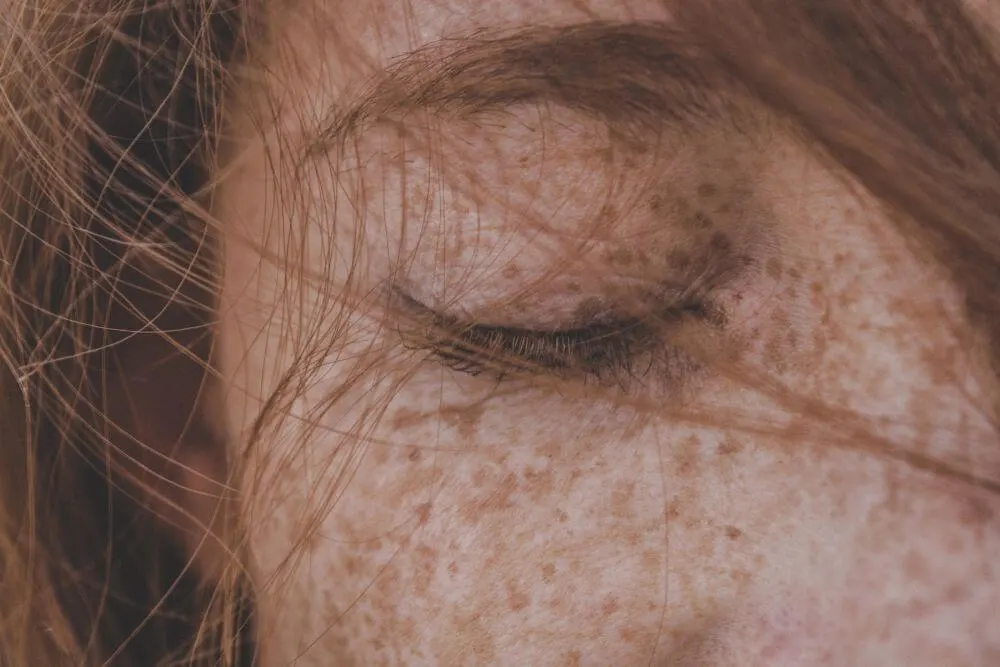
Here is an interesting fact about Ireland: Nope, not everyone in Ireland is a redhead. Only approximately 10% of all Irish people have red hair.
Yet, according to some statistics, this is the highest percentage in the world.
Northern Ireland is part of the United Kingdom and consists of 6 counties in the north east of the island of Ireland (roughly 14,000 km2 or 5,500 sq miles).
It has a population of 1.8 million. Belfast is the capital city of Northern Ireland.
English is the de facto language of Northern Ireland and the regional languages of Irish and Ulster-Scots are recognised. Pound sterling is the currency used in Northern Ireland and the rest of the United Kingdom.
The Union Jack flag is the flag of Northern Ireland.
What is Ireland famous for?
For such a small country, Ireland is remarkably famous for many things.
Among the things Ireland is most known for are its culture, drinks, food, music and sport.
From the well known St. Patrick’s Day celebrations on March 17th, to the Irish Pubs playing traditional Irish music in cities across the world, not to mention the pints of Guinness and Irish Stew, the Irish have very successfully managed to share their culture and Irishness with much of the planet.
Ireland is famous for what products?
If it is a souvenir from Ireland you are looking for, then an Aran wool sweater is one of the most famous products made in Ireland.
Ireland produces many other products as well. The country is famous for its high quality meat and dairy products, which it exports all over the world.
It is also known for its alcoholic beverages, Guinness probably being the most famous of all of these.
There are many other well known Irish drinks, including Irish Whiskey, such as Jameson, Tullamore Dew and Bushmills, as well as Bailey’s Irish Cream Liqueur and the many different Gins from the thriving gin industry in Ireland.
Other important products of Ireland’s manufacturing businesses include pharmaceutical, chemical and computer software products.
What things are associated with Ireland?
Ireland is associated with a broad range of things, here is a list of the top things Ireland is associated with:
- St. Patrick and St. Patrick’s Day Celebrations on March 17th
- The Shamrock
- Guinness
- Irish Whiskey
- Irish Coffee
- Irish Dancing (Riverdance)
- Castles
- Pubs
- Potatoes
- Irish Stew
- Soda Bread
- Gaelic Games (GAA)
- Horse Racing
- Rugby
- Irish Blessings
- Irish Traditional Music
- Irish Harp
- Modern Music (U2, Enya, Sinéad O’Connor, The Cranberries)
- Celtic Art and Culture
- Irish Literature (James Joyce, Oscar Wilde, W. B. Yeats, Seamus Heaney)
- Irish Landmarks (The Cliffs of Moher, Newgrange, Skellig Michael,
- Irish Filming Locations (Star Wars, Harry Potter, Normal People,
- Samhain (the origin of Halloween)
- Guinness Book of Records
- Claddagh Rings
If you would like to know more about what symbols Ireland is associated with from the shamrock to the harp, as well as the reasons why, you can read all about Irish Symbols here.
Things Ireland is Known For
St. Patrick’s Day
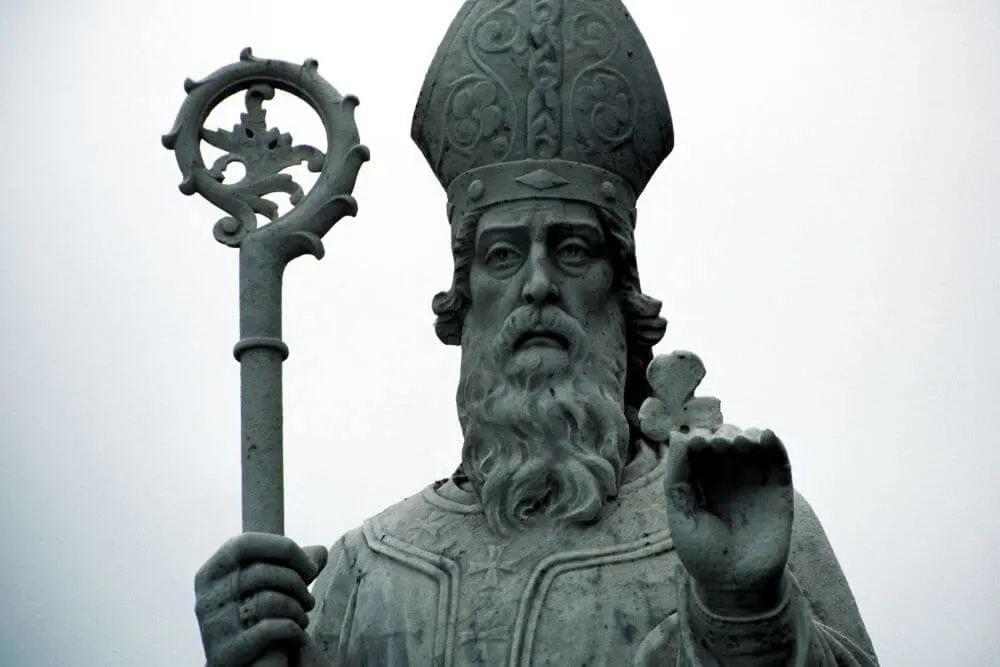
St. Patrick’s Day, the national holiday of Ireland, falls on March 17th and is celebrated as both a religious and cultural event.
Traditionally, this feast day was to mark the memory of Saint Patrick, the patron saint of Ireland, who brought Christianity to the island in the 5th century.
As a boy, he was captured by Irish pirates and brought to Ireland as a slave to shepherd sheep.
After about six years he managed to escape and returned home to Britain, but later decided to travel to Ireland once again and bring Christianity to the land.
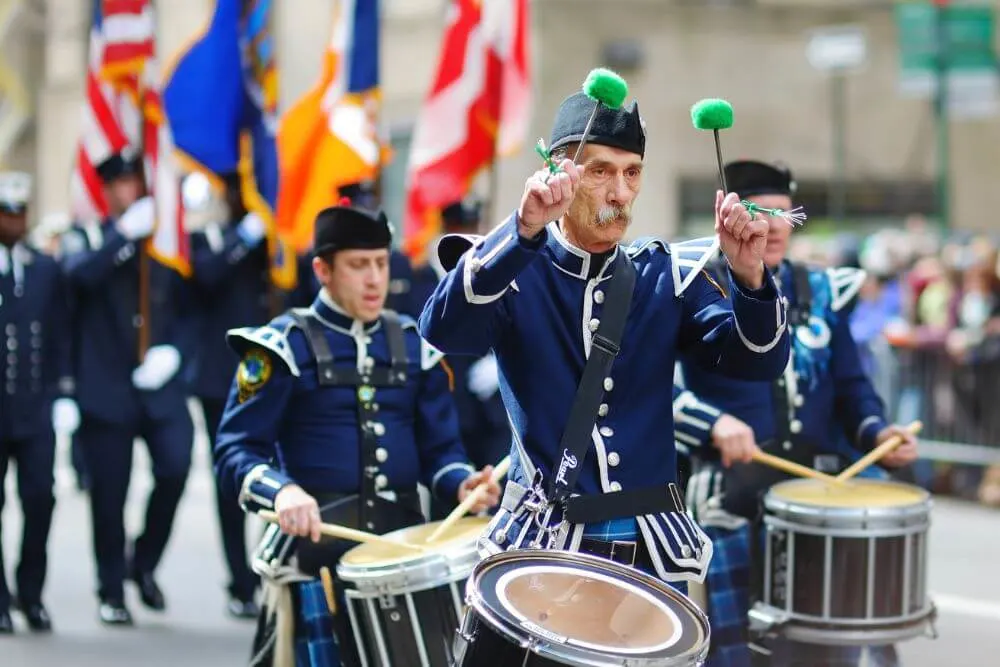
Today, St. Patrick’s Day is one of those iconic Irish things that is celebrated with parades of technicolor floats, marching bands and lots more not only in Ireland, but also in cities in the United States, such as Chicago and New York, as many other cities around the world.
There are roughly 80 million people world-wide who claim to have Irish heritage and many of them use this day to celebrate Irish culture.
In Ireland, the largest parade takes place in Dublin City and is part of the St. Patrick’s Day Festival which runs over a few days.
If you visit on March 17th, then one of the things to see in Ireland is definitely a parade!
The most appropriate day of the year for people to wear green, is of course St. Patrick’s Day!
Legend has it that the green “shamrock” was used as a tool to help St. Patrick to demonstrate the Christian Holy Trinity.
This is why people wear sprigs of green, leafy decorations on St. Patrick’s Day.
However, from a botanical point of view, there is no individual plant called shamrock.
What most people consider to be “shamrock” is likely to be young clover (Trifolium dubium) or even wood sorrel (Oxalis acetosella).
Regardless, the tradition of Irish political leaders giving gifts of crystal bowls of “shamrock” to the President of the United States and other world dignitaries continues each year!
Guinness
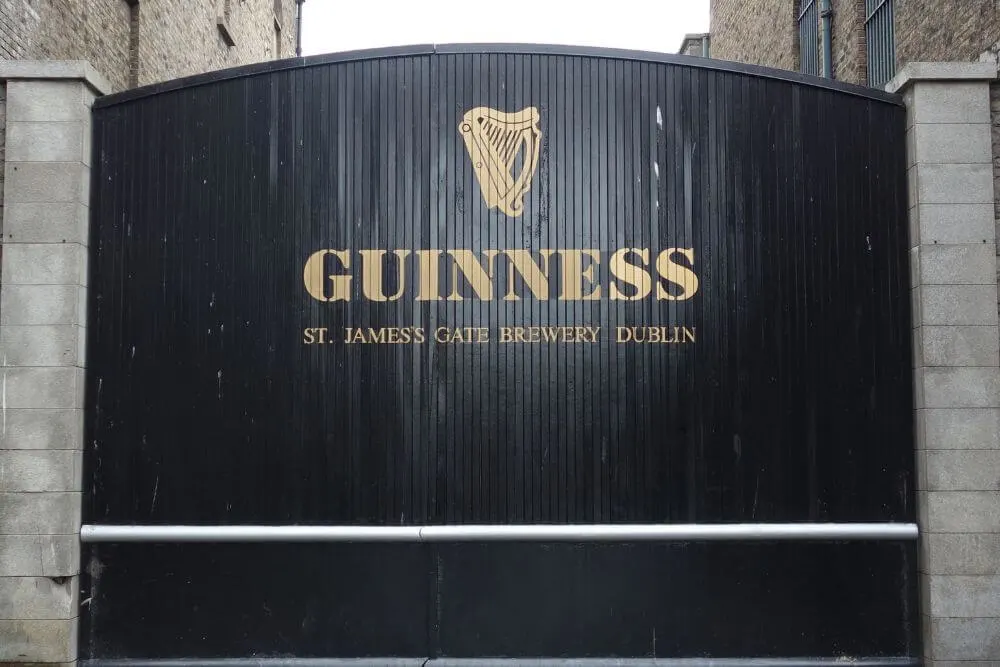
What alcohol is Ireland known for? Ireland is known for producing many different alcoholic beverages, but the one it is most famous for around the world is Guinness. The iconic black and white pint of Guinness stout is possibly the most recognisable Irish brand in the world, thanks to its worldwide popularity and excellent marketing strategies.
When Arthur Guinness signed a 9,000 year lease in 1759 for the St. James’s Gate premises in Dublin, he was aiming for great things.
But even in his wildest dreams, he could not have imagined the extent and far reaching effect that Guinness would have worldwide.
To put that in context, roughly 10 million glasses of Guinness are consumed each day!
Guinness is still brewed today at the St. James’s Gate Brewery on the banks of the River Liffey in Dublin.
While it is not possible to have a guided tour of the brewery itself, you can visit the Guinness Storehouse.
At the Guinness Storehouse, you learn all about the history of Guinness, how it is produced and even have the opportunity to pull your own pint at the Guinness Academy.
Fun Fact: Can you guess what is Dublin’s most visited attraction?
The Guinness Storehouse receives more than a million visitors a year and is not only the most visited attraction in Dublin, but all of Ireland.
By the way: Did you know that the harp on the specially designed Guinness glasses acts as a marker in the two-step pour process ensuring that each pint of Guinness (also known as the Black Stuff) is perfectly poured?
Irish Harp and Guinness
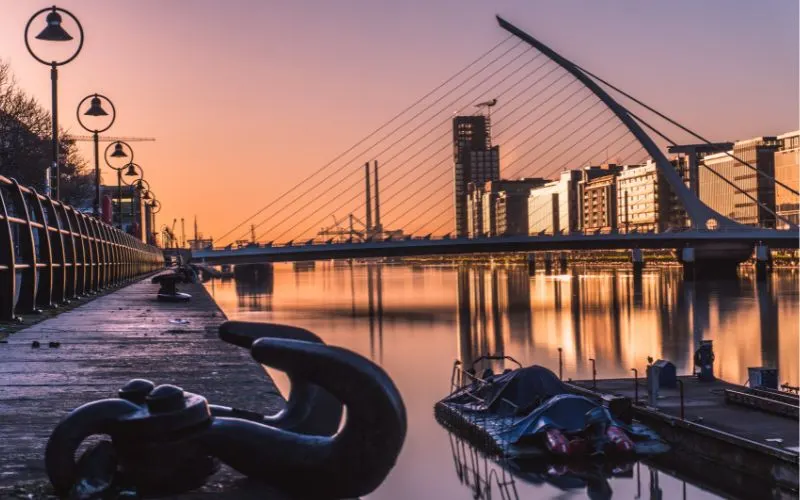
Interestingly, there is a long story about the Irish symbol of the of the Irish harp.
In the mid-19th century, Guinness was the first to register the harp as a trademark.
When the Irish State wanted to register the harp as the state emblem, it ran into difficulty.
That is why you will only see the Guinness harp facing right (flat board side on the left) and the Irish State harp emblem facing left (flat board side on the right). Just check out any Irish Euro coins to see!
Find out more about Irish coins and their history in our detailed post about the Currency in Ireland.
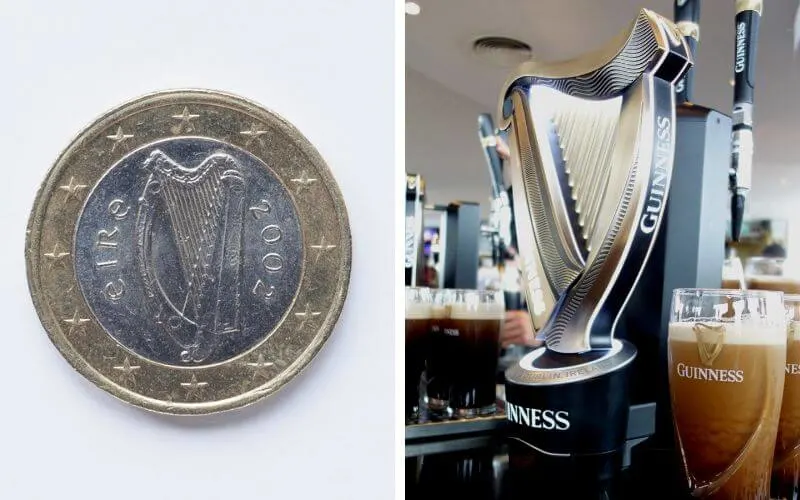
Guinness Book of Records
Guinness has also become a household name through its famous Guinness World Records, which was originally designed to settle pub arguments! The Guinness Book of Records (as it was known then), was first published in 1954 and immediately became a bestseller.
Irish Whiskey
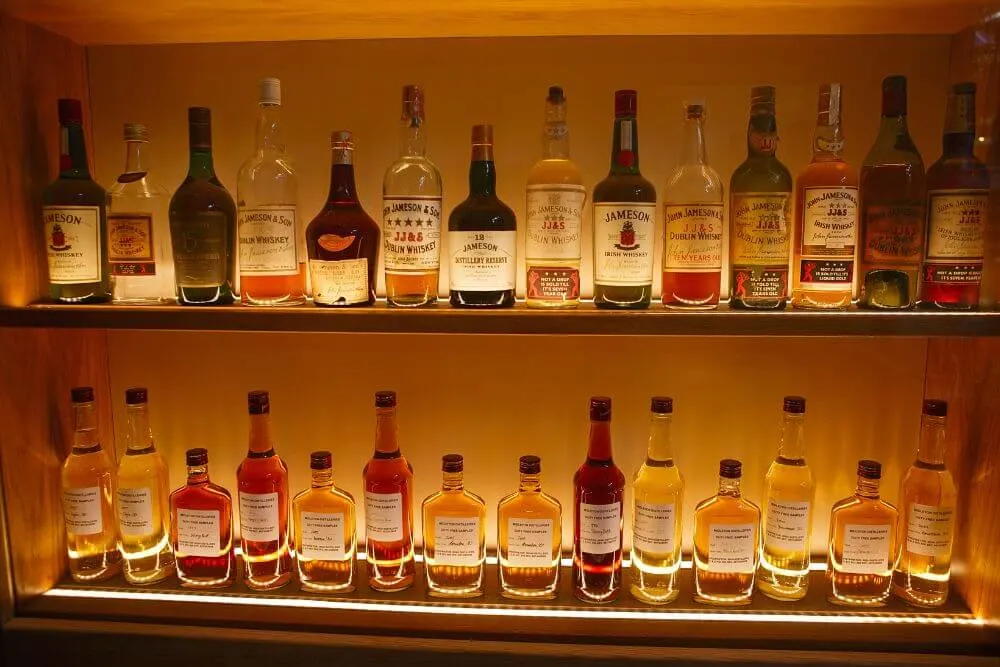
The word “whiskey” comes from the Gaelic uisce beatha, which means “the water of life”.
And it has certainly been the water of life for many generations in Ireland, as the oldest known document mentioning whiskey, the Irish Annals of Clonmacnoise, dates back to 1405.
Technically, Irish whiskey thus beats Scotch, at least when it comes to age.
Apart from the century old rivalry between the Irish and the Scottish, there is more than just an “e” that distinguishes Irish whiskey from Scottish whisky.
The Scottish distillers only use malted barley (when grain that has been soaked for some days, begins to sprout) in the pot still phase, whereas the Irish may also use a mix of malted and unmalted barley.
Nowadays, there are a variety of Irish whiskeys on the market:
- Single Malt Irish Whiskey, which is completely from malted barley distilled in one pot still within one distillery. Bushmills’ 10, 12, 16 or 21 year old single malt whiskey, Knappogue Castle Irish Whiskey, Connemara Peated Malt (Regular, Cask Strength and 12 years) or Tullamore Dew Single Malt are perfect examples of this.
- Single Pot Still Whiskey is created by a mix of malted and unmalted barley distilled in one pot still within a particular distillery. Green Spot, Powers Gold or Redbreast are fine examples for single pot still whiskey.
- Blended Irish Whiskey is a mix of the above mentioned styles. Examples are Black Bush, Jameson and Writers Tears.
- Single Grain Whiskey is distilled from a column or Coffey still, not a pot still. Teeling’s Single Grain is a great example of this type of spirit.
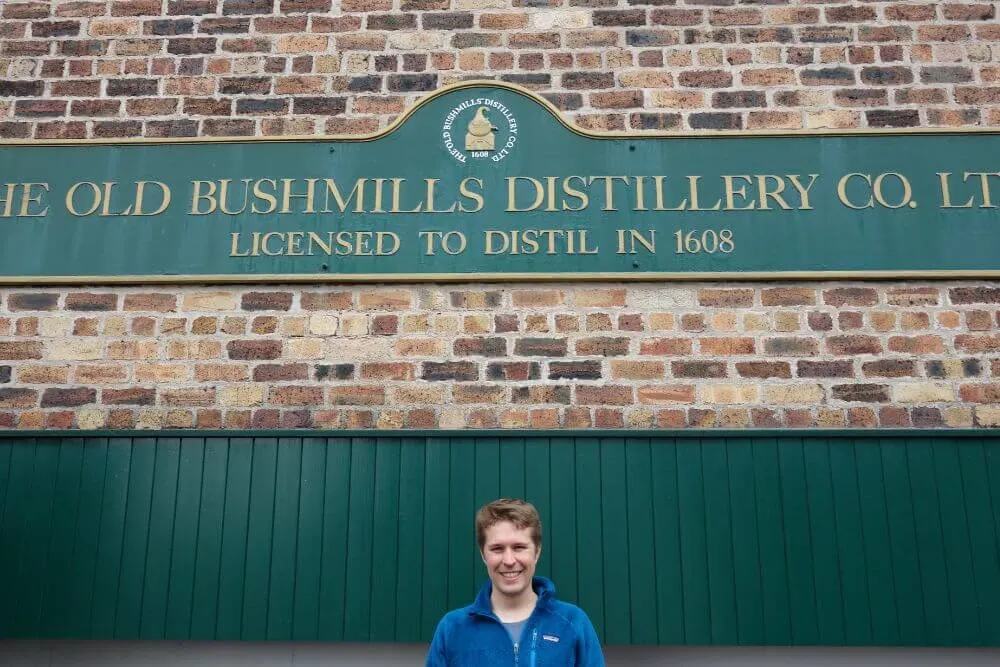
By the way, if you happen to travel to Ireland, then make sure to visit some of the fabulous distilleries first hand. As of 2019, there are 25 Irish whiskey distilleries in operation.
Some of the newer ones include Slane Distillery (est. 2018) or Ballykeefe Distillery (est. 2017).
The distillery with the world’s oldest licence to distil whiskey (from 1608!) is the Bushmills Distillery in Northern Ireland.
Some of the best whiskey tours Ireland has to offer can be found at the Teeling Distillery, which is a Dublin Liberties Distillery, and at the Old Midleton Distillery in County Cork, where you can see Jameson being distilled first hand.
In some of the distilleries, you may even be able to taste other spirits such as whiskey liqueur, vodka or gin (for example in the Dingle Distillery).
You see, there is something for (almost) everybody, who would love to sample a drop of the pure, as the Irish like to say.
If you want to be inspired by the fascinating history of Irish whiskey, I recommend listening to the podcast “A Story of Irish Whiskey”.
Irish Food
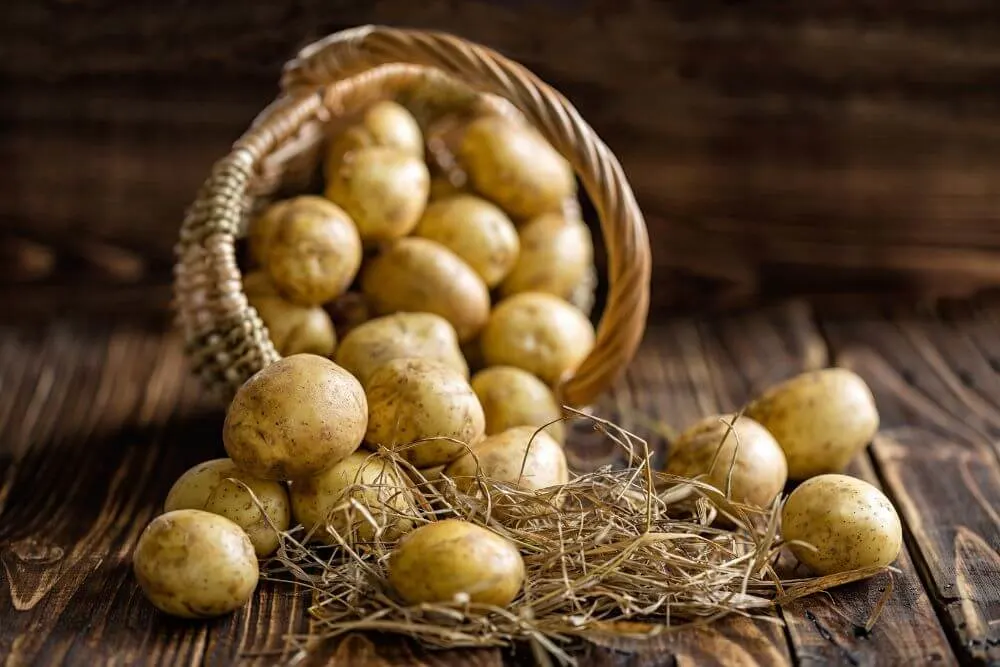
What food is Ireland famous for?
While the Irish heavily relied on the potato as the main source of food for many years, this is no longer the case.
Tasty traditional dishes, like the Irish Breakfast, as well as more gourmet foods are found in Ireland today.
In fact, the Irish are known for their street food culture and thriving farmers markets.
If you get a chance to wander about one such market, be sure to sample the tasty gourmet products and you will be sure to find all of the ingredients you need for delectable traditional Irish food recipes.
(Ever wonder what is Cork famous for?
Well it certainly is renowned as a foodie paradise. From the culinary delights in the Old English Market in the city center to the plentiful gourmet restaurants in Kinsale and beyond.
(Cork is arguably the capital of taste.)
Is Ireland famous for potatoes?
Is Ireland known for potatoes?
This is true because the humble potato has been a staple in the Irish diet for centuries.
The reliance on this crop, which failed due to potato blight in the mid 19th century, resulted in a widespread famine leading to mass deaths and emigration.
Today, there are many tasty potato and non-potato based traditional Irish foods that you should try if you travel to the Emerald Isle: Irish soda bread, black pudding or blood sausage, salted Irish butter, and the famous Tayto crisps (which are very popular in Ireland) to list but a few.
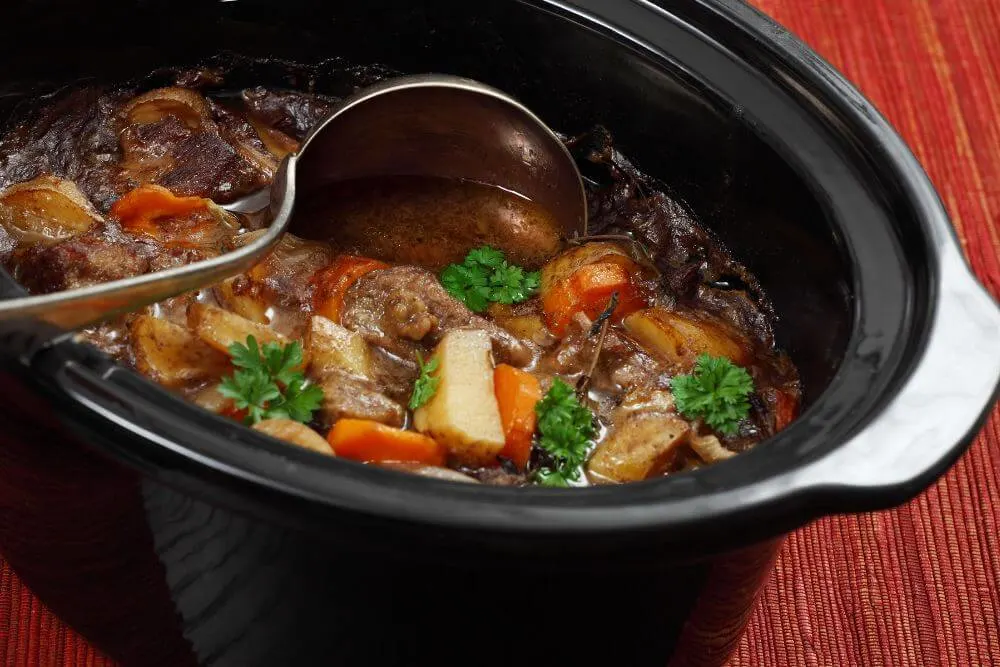
Other Types of Food Ireland is Known for
Some popular Irish cuisine to get your taste buds watering include smoked salmon on brown bread and beef or lamb Irish stew (or even a Guinness Stew if you fancy!).
These Irish specialities are popular Irish pub food dishes served on the larger premises and most seem to go very well with a pint of Guinness (or a fine Irish whiskey).
Some of the lesser known Irish dishes are coddle (one thing Dublin is famous for), which is a mix of leftover sausage, bacon, potatoes, onion and seasoning and boxty, a potato pancake made of grated and mashed potatoes along with flour, buttermilk and egg.
This dish is a great comfort food and is particularly popular in the northern counties and in Northern Ireland.
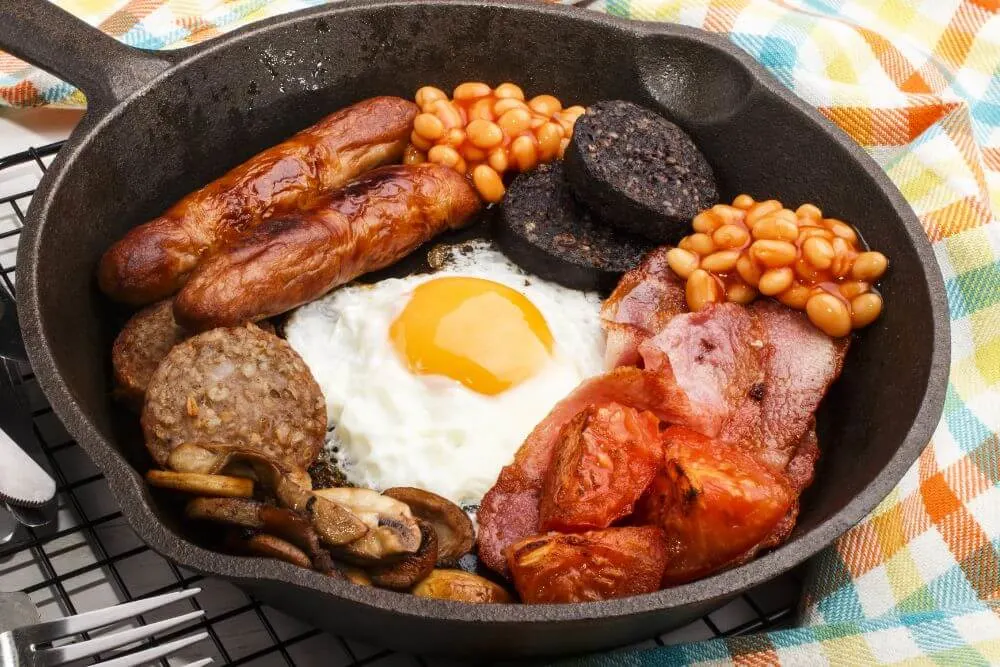
One of the things that is likely to greet you in the mornings in most hotels and bed and breakfast accommodation is the full Irish breakfast, which is one of the most famous things from Ireland.
It usually consists of fried or scrambled eggs, bacon strips called rashers, sausages, black and white pudding, fried tomatoes, baked beans and toast.
While not the healthiest way to start your day, it is very tasty and one of the more popular things in Ireland to eat (often at the weekend)!
Irish Pubs
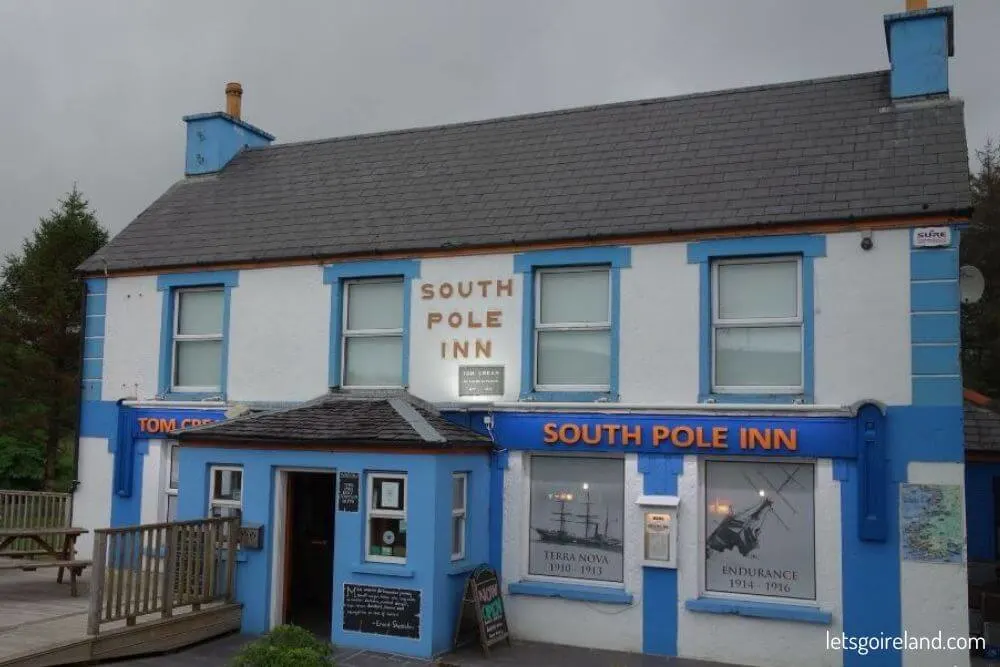
What is Ireland most known for worldwide? It is difficult to say, but Irish pubs must feature high up on the list. It is worth remembering that although you can visit Irish pubs all over the world, you will have to come to Ireland to sample the real thing.
Visiting Irish pubs in Ireland is definitely one of these things to do in Ireland that you have to try.
The easy-going atmosphere, craic (fun) and lively banter in an original traditional Irish pub is completely unique and will leave you craving for more.
Conversations with strangers flow easily over the lively traditional Irish music.
If you are lucky, you might even get the chance to join in some traditional céilí dancing!
This is just one of the things Ireland is famous for!
Check out the pubs in County Clare on the Wild Atlantic Way for some of the best music.
Next to different sorts of Irish beer, often you can also taste the Irish cuisine in Irish pubs.
By the way: According to the Guinness Book of Records, the oldest pub in Ireland is Sean’s Bar in Athlone
Irish Castles
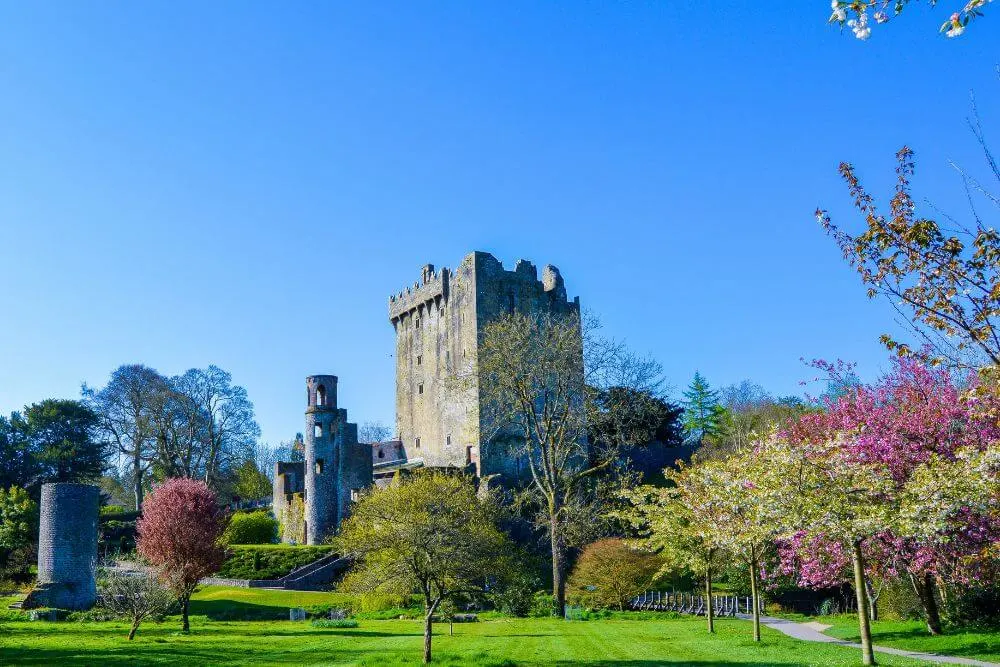
Dotted around Ireland’s landscape are hundreds of castles and some of them are included in the top Ireland tourist attractions.
Arguably, Blarney Castle with its famous Blarney Stone has one of the most internationally recognizable names.
An Irish legend has it that when you kiss this particular stone you gain the gift of eloquence.
Many Irish castles are in ruins and only with imagination can you get a sense of the grandeur and importance that these historic fortresses once held (Dunamase Castle in County Laois is a fine example of this).
Other castles, such as the castle hotels of Ashford Castle in County Mayo and Lough Eske Castle in County Donegal are truly fit for modern day kings (and offer guests luxurious stays in magnificent surroundings).
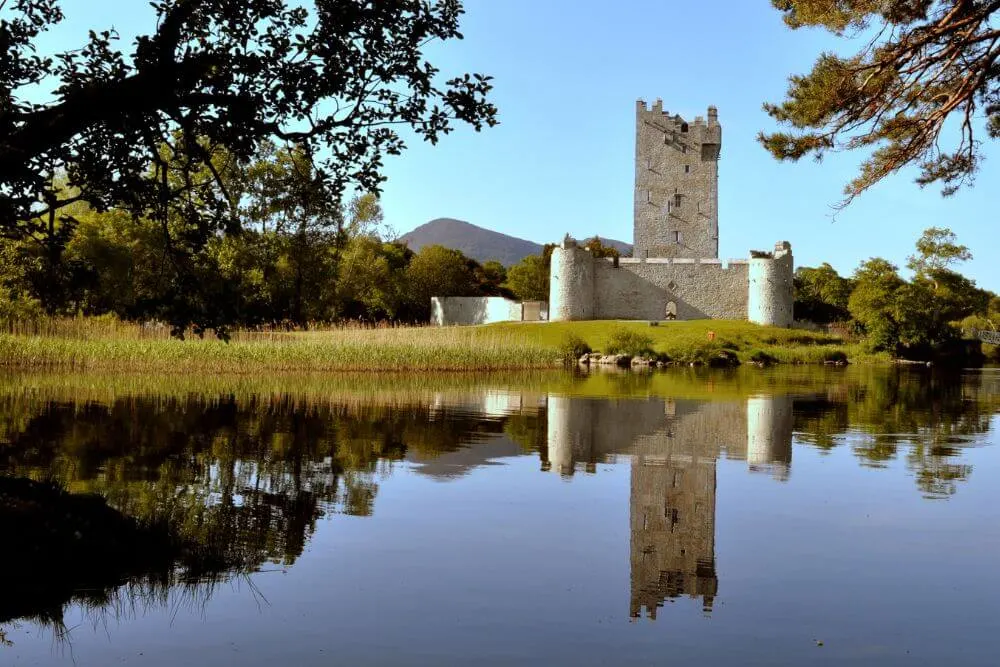
The strategic, and often very scenic, locations of many of Irish castles set them apart.
Just think of Ross Castle on the banks of the Lakes of Killarney or Dunluce Castle in Northern Ireland, which is literally perched on a clifftop.
Cahir Castle is one of our favorites, as it not only offers a great tour, but is also very well preserved and has a working drawbridge gate (portcullis) and moat.
There are lots of other castles that are also worth visiting such as the 15th century historic Bunratty Castle in Co. Clare (with the 19th century Folk Park) or if sampling a medieval banquet tickles your fancy then stop by Dunguaire Castle in County Galway.
Other great castles are Kilkenny Castle, Trim Castle (County Meath), Ballynahinch Castle (County Galway), Leap Castle (County Offaly), Tullynally Castle (County Westmeath) and Dunguaire Castle (County Galway).
Irish Blessings
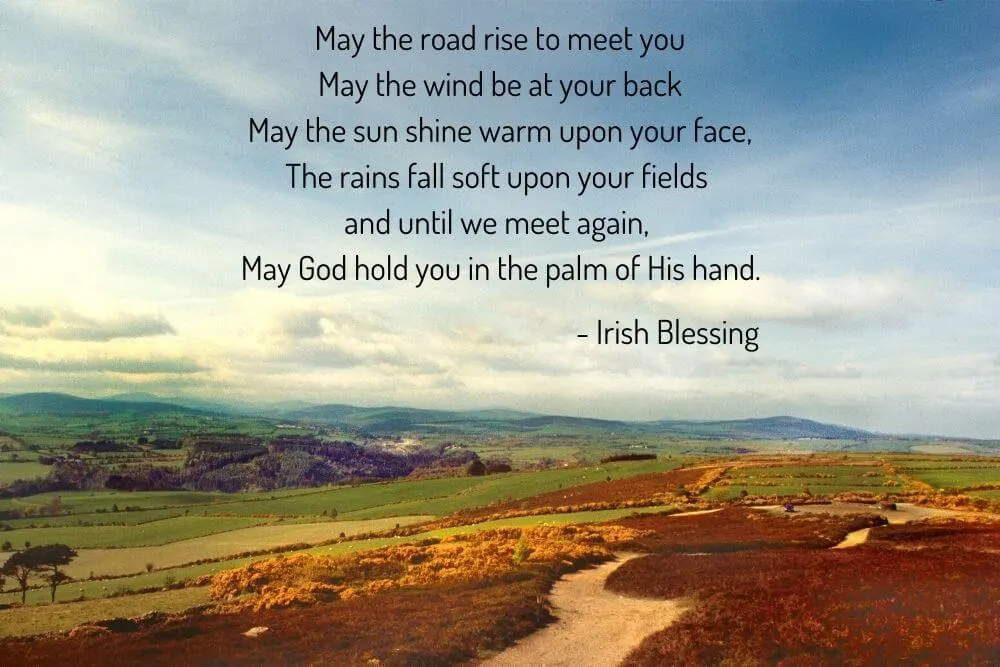
There is a long tradition of blessings and sayings in Ireland.
It is now easy to find a blessing to suit every single occasion, regardless of whether it is for a happy event such as a birthday, wishing someone luck or for when a loved one passes away.
Be warned though that some Irish blessings are very blunt, but this is part of their humorous style.
The most famous Irish blessing is often known as the Irish Prayer.
This simple blessing fits many occasions and is often used when parting to wish someone luck or strength for a journey or difficult time ahead until you meet each other again.
Irish Literature
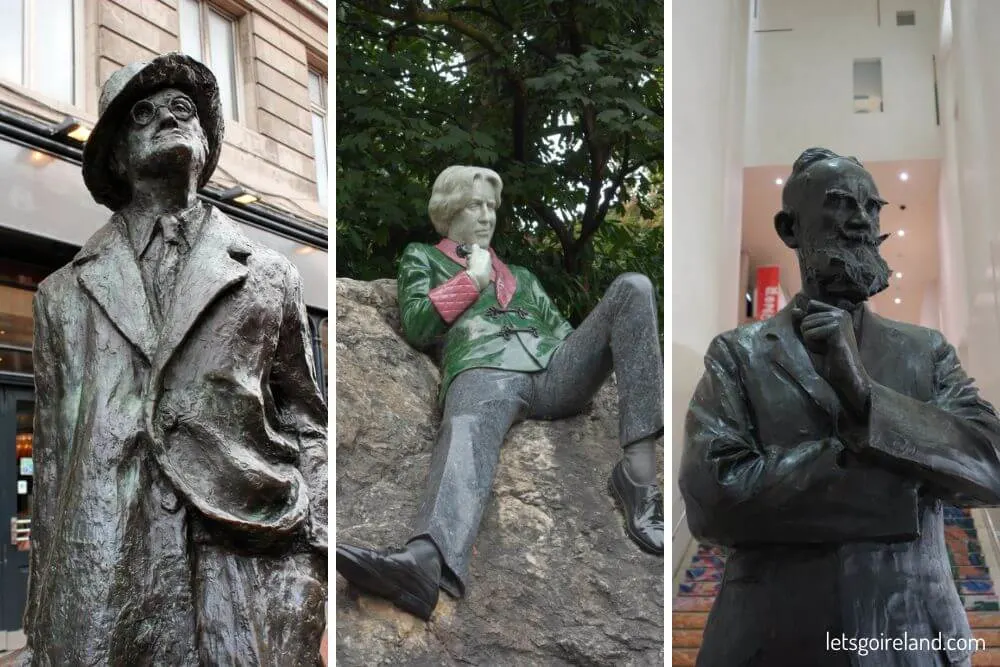
Ireland definitely has its name firmly on the world stage when it comes to literature.
Since 2010, Dublin has been designated as a UNESCO City of Literature and boasts four Nobel laureates in literature (W. B. Yeats (1923), George Bernard Shaw (1925), Samuel Beckett (1969) and Seamus Heaney (1995)).
Not bad for such a small country on the edge of Europe!
Good storytellers are just one of the things associated with Ireland, and I guess there is some truth in this!
James Joyce is one of the best known and his name will ring a bell with many for his masterpiece “Ulysses”, which details the lives of several characters on a single day in June 1904.
Thanks to this famous person from Ireland and his book, each year on June 16th, Bloomsday, Dublin comes alive with people in costume reenacting scenes from Ulysses.
The other Irish famous for literature include:
- the witty and flamboyant Oscar Wilde known for his short stories, plays and novels (e.g. “The Picture of Dorian Gray”)
- Bram Stoker who captured imaginations with “Dracula”
- Jonathan Swift for his creative “Gulliver’s Travels”
- Maeve Binchy for her take on life in Ireland in novels such as “Circle of Friends” and “Copper Beech”
- Sebastian Barry for his award winning fiction including “The Secret Scripture”, Frank McCourt‘s heartbreaking “Angela’s Ashes“
- Roddy Doyle with his funny “Paddy Clarke Ha Ha Ha” or “The Commitments”
- Cecelia Ahern whose novel “P.S. I Love You” became an international bestseller
Btw: You could easily continue this list of Irish known for their writing talents… Anne Enright, Brendan Behan, William Trevor, J. M. Synge, Tana French, John Banville, Hugo Hamilton…
While authors from the 19th and 20th century are most famous and known, Ireland has a rich history of literature and book crafts dating back centuries.
It is worth mentioning that the Book of Kells in Trinity College Dublin, dating from the 8th or 9th century, is an exquisite example of the impressive craftsmanship involved in the illumination of the four Gospels.
Celtic Art and Celtic Culture
While authors from the 19th and 20th century are most famous and known, Ireland has a rich history of literature and book crafts dating back centuries.
It is worth mentioning that the Book of Kells in Trinity College Dublin, dating from the 8th or 9th century, is an exquisite example of the impressive craftsmanship involved in the illumination of the four Gospels, using the Insular style (also known as Hiberino-Saxon style) found in Ireland and Britain.
Other examples of Celtic art and knotwork can be seen in the high crosses of Ireland.
Irish Sports
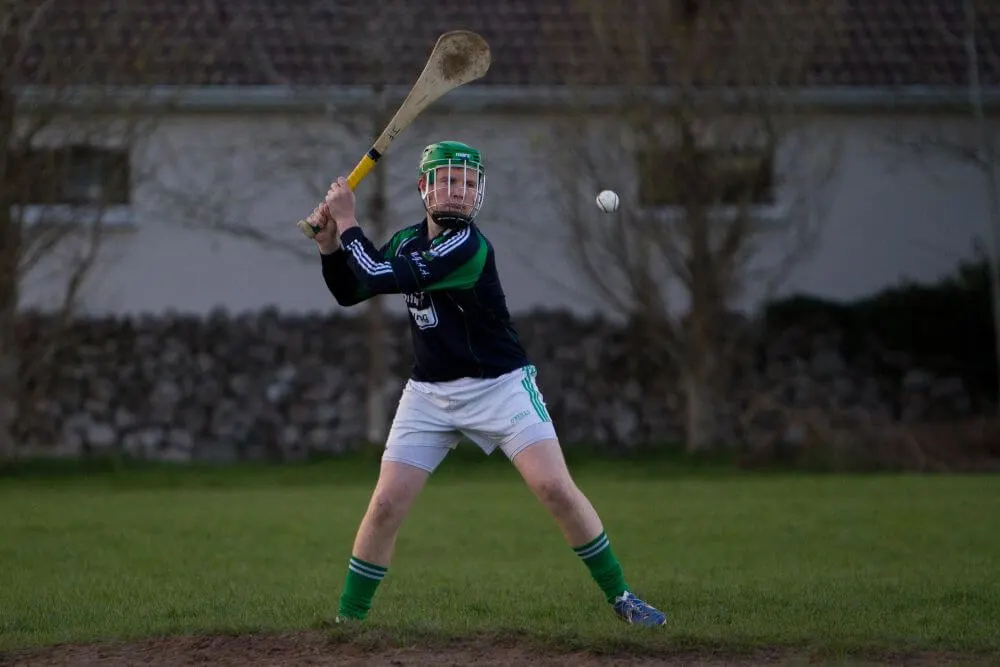
Gaelic Games (GAA)
Ireland has a very proud sporting tradition, particularly when it comes to its native Gaelic games.
GAA (Gaelic Athletic Association) is a sporting organisation that primarily promotes
Gaelic sports including camogie, hurling, and mens and ladies Gaelic football, but also focuses on things that are Irish as well, such as culture, music and dance.
This amateur sporting organization is popular in Ireland as well as with Irish diaspora abroad and thus has more than 500,000 members worldwide.
Each year, all of the 32 counties on the island of Ireland battle each other for the glory of winning the All Ireland Final in camogie, hurling, and ladies and mens Gaelic football.
The All Ireland Finals, which are held in Croke Park, Dublin, in September every year, are some of the biggest sporting fixtures in the Irish calendar year.
Irish Rugby
In recent years, Irish rugby has surged in popularity and before a big match the whole country seems to gain a particular buzz.
Ireland has won the annual Six Nations Championship, which takes place between Scotland, France, England, Wales, Italy and Ireland, 14 times in total.
Three of these are even grand slams (1948, 2009 and 2018).
A grand slam means that a team has not lost a single game in the tournament.
Irish Horse RacingIreland is a major player on the international horse racing scene as well and has a long tradition of producing excellent thoroughbred horses for horse racing.
In Ireland, horse racing is a much enjoyed spectator sport with numerous race meetings and festivals taking place across the country on an annual basis.
The Curragh Racecourse in County Kildare is one of the best known flat racecourses (without obstacles or jumps for the horses) and is where the five Irish Classics (Irish 1,000 Guineas, Irish 2,000 Guineas, Irish Derby, Irish Oaks and Irish St. Ledger) take place. National hunt racing, in which the horses must jump over obstacles such as hurdles or fences, originates from Ireland.
Punchestown Irish National Hunt Festival usually takes place in April and is one of the main highlights of the Irish racing year.
One of the most famous jockeys is Anthony Peter McCoy, who is from Northern Ireland.During his professional career he rode 4,358 winning horses which is a very impressive record.
Irish Music
For a small island, with a population of roughly 5 million, Ireland has produced some astounding homegrown music talent.
Credit must be given to The Dubliners and The Chieftains for their respective roles in popularizing traditional Irish music on an international stage over the last few decades.
Btw: this kind of traditional Irish music or Irish folk music can be heard almost anywhere in Ireland, for example in a good Irish pub.Ireland also has a strong culture of busking or street music.
What is Galway famous for? Its lively street buskers of course!
This is one thing that makes Galway stand out in comparison to other cities in Ireland.
Visit the city on a busy day in summer to hear the street music at its best!
Ireland has also dominated charts with popular music from the likes of:
- the massively successful band U2
- the unforgettable Sinéad O’Connor
- the unique voice of the late singer Dolores O’Riordan of The Cranberries
- the songwriting genius “Van The Man” Van Morrison
- Enya’s haunting melodies
- Boyzone’s boy band pop songs
- the Dublin hard-rock band Thin Lizzy
- or the greatest guitarist in the world (according to Jimi Hendrix), Rory Gallagher.
The Eurovision Song Contest has changed a lot since the early 1990s when Ireland dominated the winner board for four out of five years.
In total, Ireland won the Eurovision seven times since the show began in 1956 and came first in the international ranking list of this competition.
One of the most successful acts to ever come out of the Eurovision was the interval act of the 1994 Eurovision: Riverdance.
The groundbreaking performance of Irish dancing and music went on to be a global phenomenon and is still being performed today.
Ireland Filming Locations
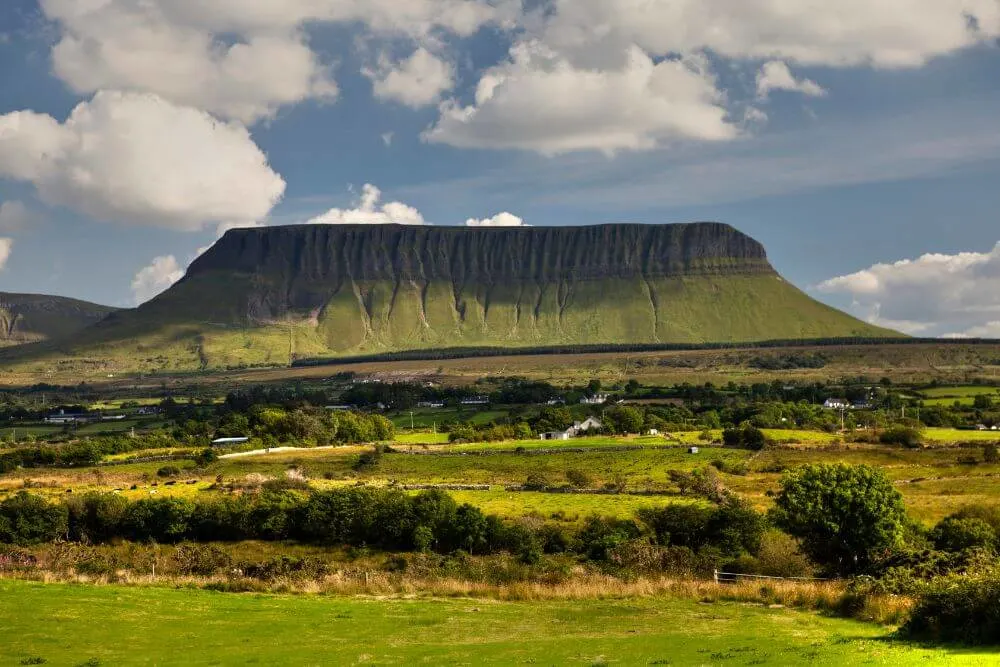
Ireland has its foot firmly on the world stage when it comes to filming locations. Some of the biggest productions of recent times have been shot on location in both Ireland and Northern Ireland.
Besides the biggies mentioned below, you may recognize the Irish landscape in many films including Ryan’s Daughter, The Quiet Man, Moby Dick, P.S. I Love You, Saving Private Ryan and Braveheart. Among the recent popular series that have been filmed on the isle of Ireland are Derry Girls (County Derry).
Game of Thrones Ireland
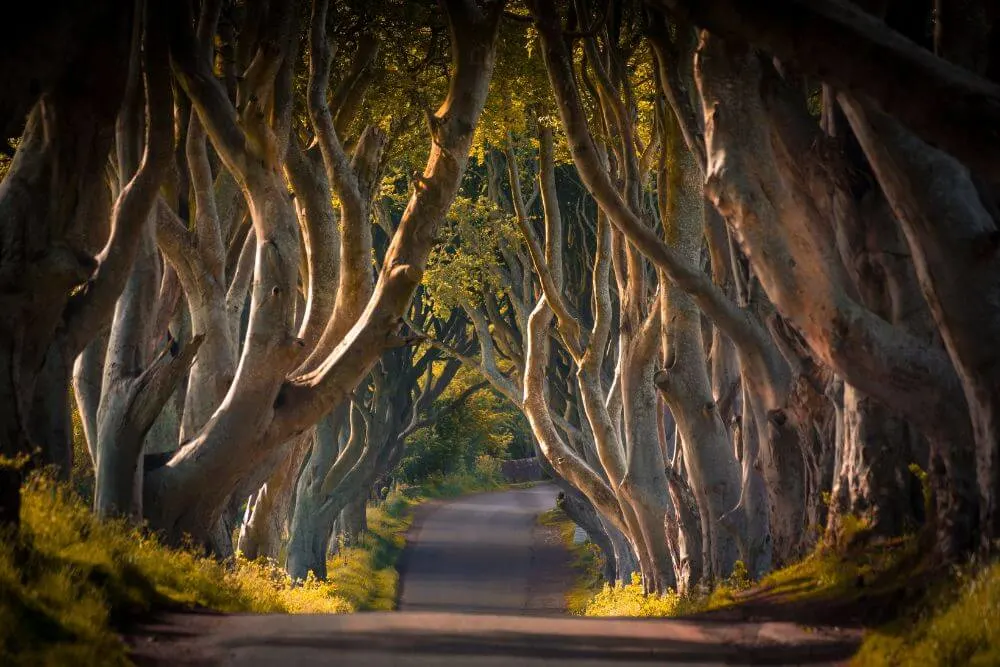
Game of Thrones, the record breaking HBO series, is one of the popular television phenomenons of recent times and throughout all 8 seasons much of the filming was shot on location across Northern Ireland.
Some of the most memorable scenes were filmed in the Stark home of Winterfell at Castle Ward, Tollymore Forest Park, Inch Abbey, Cushendun Caves, Murlough Bay, Ballintoy Harbour, Carrick-a-Rede Rope Bridge, Downhill Strand and Portstewart Strand.
These locations were utterly transformed into scenes from the Seven Kingdoms.
There are several different Game of Thrones tours that will bring you to these Game of Thrones filming locations.
If you fancy a shorter tour, then a Game of Thrones tour of Belfast is also possible.
Star Wars Filming locations Ireland
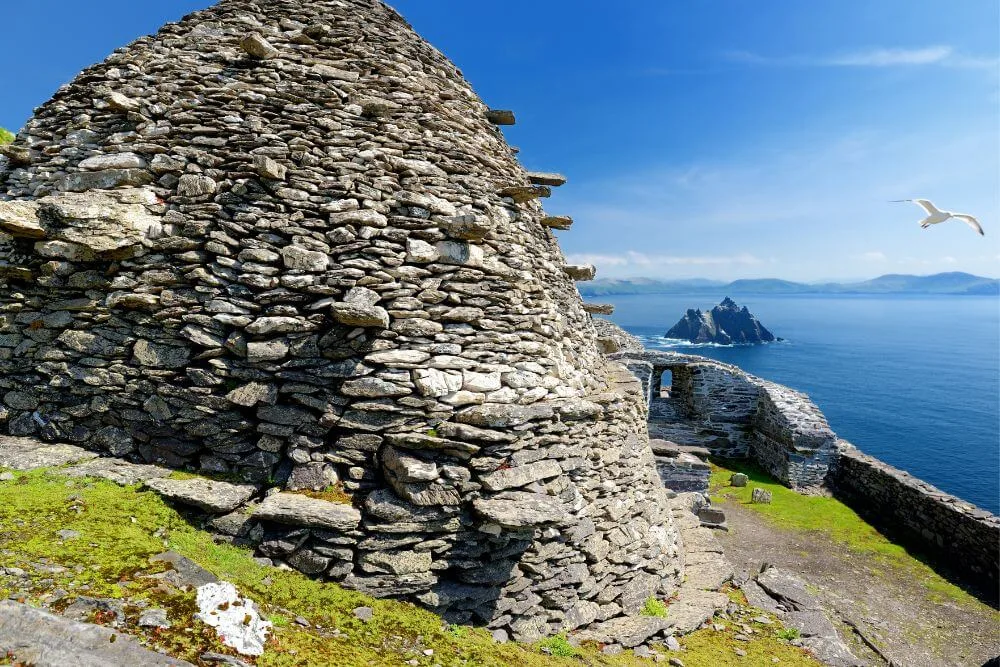
Star Wars VII (The Force Awakens) and Star Wars VIII (The Last Jedi) was filmed on Skellig Michael off the coast of County Kerry.
The isolated rocky outcrop, which was a monastic settlement for centuries, provided the perfect inspiration for Luke Skywalker‘s retreat to Ahch-To.
The unique beehive shaped stone huts that the monks lived in are still very well preserved to this day. Nowadays it is also a bird sanctuary.
Among other bird species, here you can spot beautifully beaked puffins.
Film crews returned again to Ireland to film at several other locations in Kerry and along the west coast for Star Wars IX (The Rise of Skywalker). For exact details about the filming locations, read our ultimate Star Wars guide here.
Harry Potter Filming locations Ireland
One very sensational scene in “Harry Potter and the Half-Blood Prince” was filmed in Ireland and involved two filming locations.
Harry and Dumbledore are seen perched on the smallest of the Skellig Islands, Lemon Rock, which was digitally repositioned in front of the towering Cliffs of Moher.
Although the actors did not get to experience standing on the rock in real life, it does make for extremely dramatic footage.
Check our comprehensive Harry Potter Ireland guide here.
Normal People Filming Locations Ireland
What is Sligo famous for? Many things of course, but recently Sligo became exceptionally well known for its incredible, highly underrated scenery. Much of the stunning landscapes features in the series Normal People were shot on location in Sligo.
This is the guide to where you will find these scenes, including the breathtaking Streedagh beach.
Famous Irish People
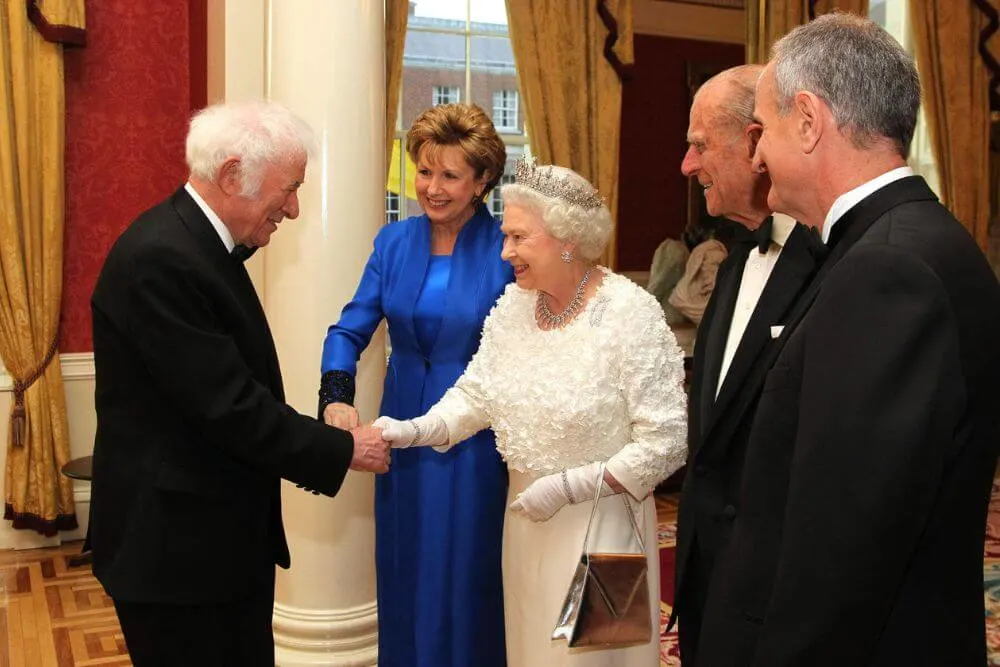
The list of famous Irish people is quite a long one as the Irish have excelled in many different fields ranging from science and medicine to the arts.
Their achievements are known throughout the world and help to make the Emerald Isle of Ireland more recognisable on the international stage.
The people mentioned below were either born in Ireland or in Northern Ireland or hold Irish citizenship.
Well known Irish people of modern times include the famous Irish actors Liam Neeson, Colin Farrell, Saoirse Ronan, Cillian Murphy, Pierce Brosnan, Brendan Gleeson, Michael Gambon and Gabriel Byrne.
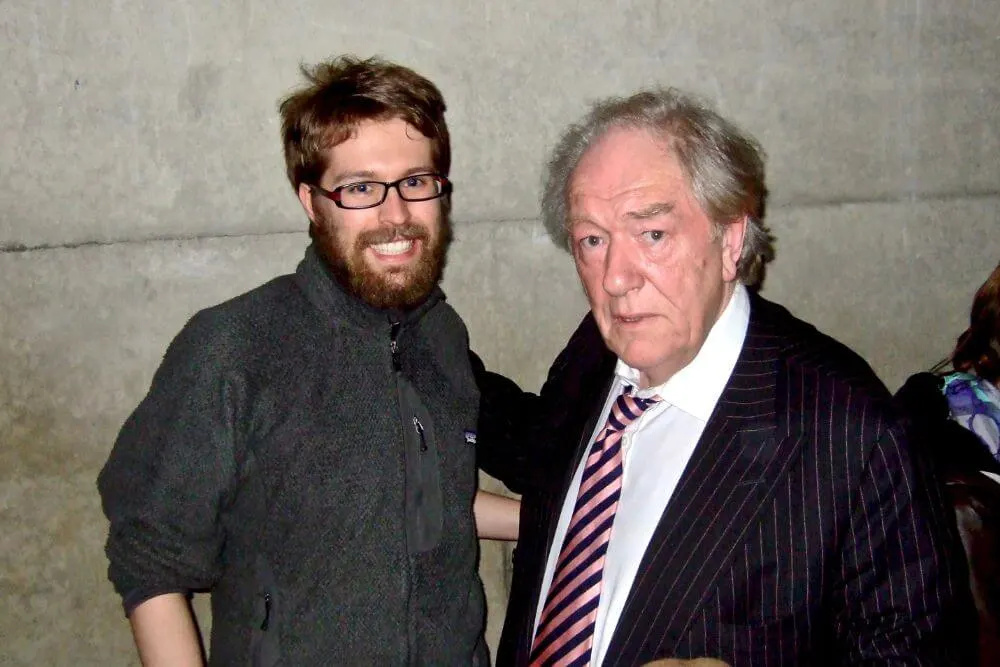 Nils and Dumbledore actor Michael Gambon. (Photo: www.letsgoireland.com)
Nils and Dumbledore actor Michael Gambon. (Photo: www.letsgoireland.com)
Some of the most internationally famous Irish sports stars include Katie Taylor (boxing), Pádraig Harrington (golf), Brian O’Driscoll (rugby) and Conor McGregor (mixed martial arts).
This list of songwriters and musicians that Ireland is famous for is seemingly endless, but some of the most recognisable Irish figures include Bono (lead singer of U2), Van Morrison, Sinéad O’Connor, Christy Moore, Hozier and Niall Horan.
Other notable famous Irish women include Mary Robinson (former president and United Nations High Commissioner for Human Rights), Meave Binchy (deceased novelist and short story teller), the Irish dancer and seducer Lola Montez and the Irish pirate queen Grace O’Malley.
Famous historical Irish people include:
the authors, playwrights and poets James Joyce, Oscar Wilde, George Bernard Shaw and W. B. Yeats.
- the scientists Francis Beaufort (creator of the Beaufort Scale) John Tyndall (who discovered that the sky is blue) and Ernest Walton (Nobel Prize Winner and first scientist to split the atom together with John Cockcroft)
- and the famous Irish politicians Charles Stewart Parnell, Michael Collins, and Éamon de Valera.
Ireland Famous Landmarks
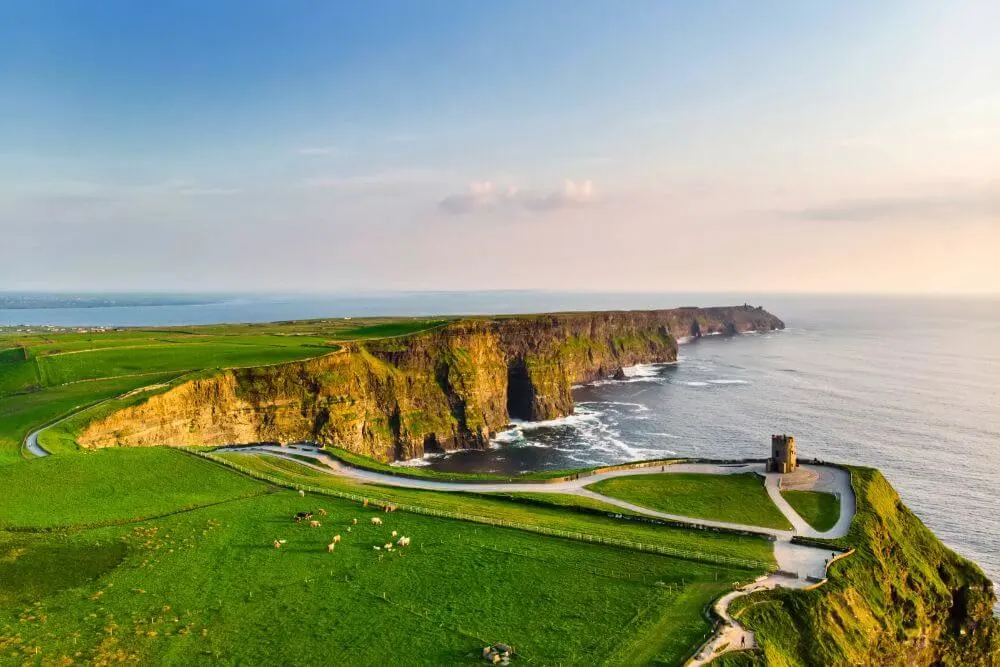
In Ireland famous places with breathtaking landscapes and unique landmarks are plentiful. Some of the most striking Irish landmarks are included in the list of UNESCO World Heritage Sites.
In the Republic of Ireland, these are the isolated ancient monastic settlement of Skellig Islands off the coast of Kerry and the Brú na Boinne monument complex with Newgrange in County Meath.
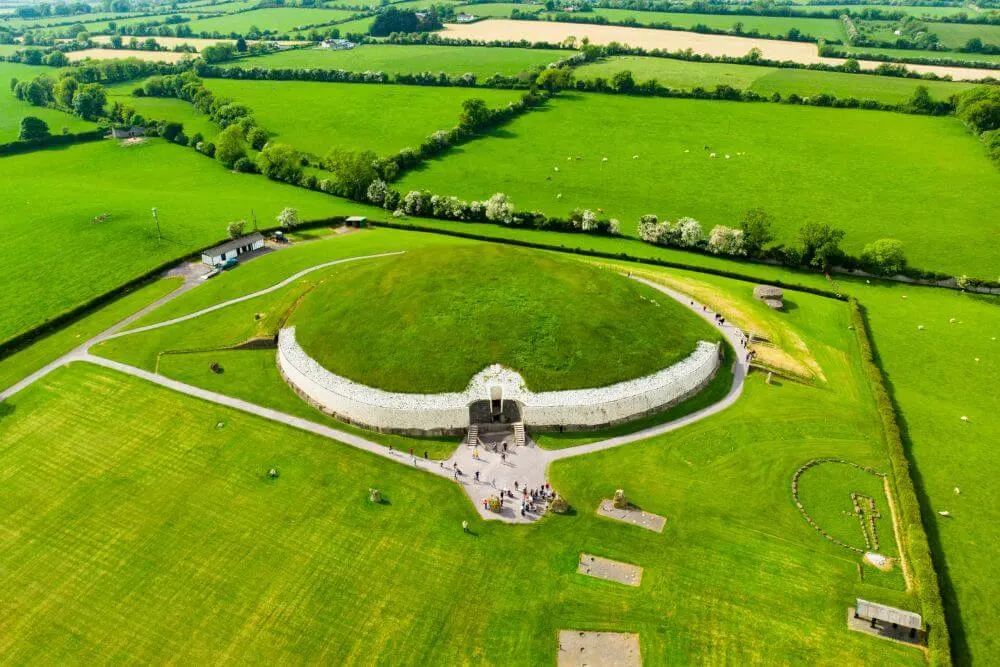 Newgrange passage grave in County Meath. Photo: MNstudio via Canva)
Newgrange passage grave in County Meath. Photo: MNstudio via Canva)
Other iconic natural landmarks of the Emerald Isle include the beautiful Cliffs of Moher, the unique lunar-like terrain of the Burren in County Clare and the Lakes of Killarney in Killarney National Park, County Kerry.
These are famous in Ireland and beyond.These can all been seen as part of the Wild Atlantic Way coastal drive from Malin Head in County Donegal that follows the west coast down through the Dingle Peninsula and finishes in Kinsale in County Cork.
In Ireland famous things of historical significance that people come to visit include:
the cliff top fort of Dún Aonghasa (also known as Dun Aengus) on the Aran Islands
the Glendalough monastic settlement in Wicklow National Park that was founded in the 6th century
and one of the most famous places in Ireland is Blarney Castle with its internationally known Blarney Stone in County Cork
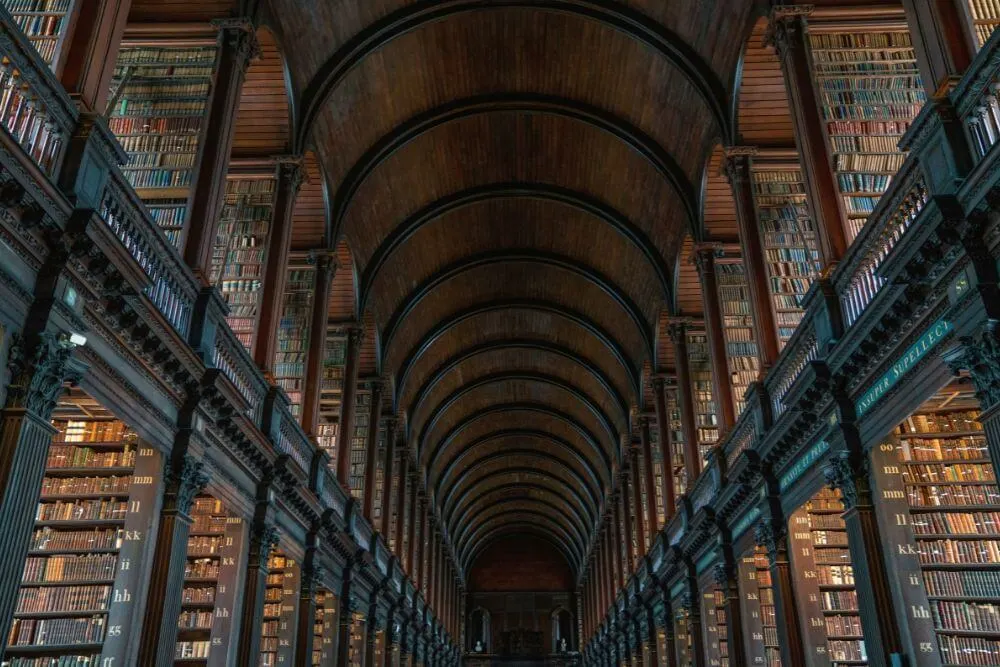 The Long Room Library of Trinity College Library is one of those libraries that can leave you speechless. (Photo: Noah_Jurik via Canva)
The Long Room Library of Trinity College Library is one of those libraries that can leave you speechless. (Photo: Noah_Jurik via Canva)
Dublin has many famous landmarks including Trinity College Dublin and its impressive old library situated in the barrel-vaulted Long Room Library.
The Spire on O’Connell Street was completed in 2003 and is one of the most instantly recognisable features of the city towering 121 meters (ca. 394 feet) into the air.
The Guinness Storehouse has also become a must-visit landmark in the capital with its bird’s eye view of the city from the Gravity Bar.
What is Northern Ireland famous for in terms of landscapes?The Giant’s Causeway in County Antrim with its basalt columns is also designated a UNESCO World Heritage Site and one of the most identifiable landscapes in Northern Ireland.
Belfast is also famous for its skyline, which includes the Harland and Wolff cranes in the shipyard that built the Titanic.
Irish Symbols
Still interested to find out more about Ireland? Then your next stop should be Irish symbols, where you’ll find out all about the symbols associated with Ireland and why.
This post may contain affiliate links. If you click on one of them, we might receive a small commission (at no extra cost to you). Thanks for your support!
